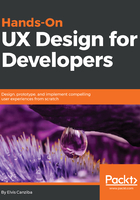
UX analysis
UX analysis is another stage of the UX process. It helps us to measure the interaction between a user and user interface; often, in this case, it can be an application, a digital product, or even the design itself.
You can do UX analysis in different ways and using different approaches. We covered some of them, such as competitor analysis and task analysis.
When we are creating a UX analysis, it is always important to keep in mind all the aspects that are connected with the product we want to build, such as:
- User perspective
- Business perspective
- Expert team's perspective
- Technical perspective
Refer to the following diagram:

The UX analysis includes different methods that vary in terms of formality and user participation. Then, by combining the results of these different tests, we will be able to create an overview of who our community is, as follows:
- Who our customers are
- Where our user category is
- What information they need and seek
- How they prefer to access that information
Often, during the UX analysis phase, when we analyze users, it leads us to change the product design or its features, especially on the interface side.
The part where we improve our product design or mobile and web-user interface to have better user engagement and make the product work for them is called the UI design; we will discuss this more in the next stage of the UX process, which is the design part.
Analyzing the user experience leads us to new design changes, but those changes help us to engage customers with our product, make them use our product often, and also lead us to other new customers.
The following are some of the methods used for measuring the UX analysis:
- A/B testing
- Heat-mapping
- Research group
If we have to deal with a digital product, such as a mobile or web application, we can use external tools or services, such as Google Analytics, Hubspot, Moz, or CrazeyEgg, and tons of other tools available on the market.
Using A/B testing, heat-mapping, or other analytical tools, we can measure how users are interacting with our product through the statistical information that will be provided by that specific method.
We have to display the things that are important to interact with in our product. The key here is not to add tons of buttons, features, and possibilities, but to provide the elements that make sense for users; take a look at the following remarkable quote from Steve Jobs:
If we don't focus on our main goal of why we started the product in the first place, by adding too many features, we will create too much noise for our users. We have to avoid saying yes to every feature, focus on the main one, and work hard on it. If we add many features, we will reduce the flexibility and increase the complexity, and it will take more time for the user to understand it, and, in other words, the product will be complicated.
Research is a key value in the UX process, but in order to use the data that we found during the research phase in a proper way, we have to analyze and prepare it for the team. Analysis is the process where we, as researchers, identify the patterns in research, propose other possible solutions, and make new recommendations.
Sometimes, during analysis, we will need to include techniques for creating different personas and different scenarios, and describe the user's behaviors in detail by providing different graphs or chart statistics to our team. Conducting research is an important part, but we have to understand that the research itself has value only if we share it; if we keep it for ourselves, no analysis can be done related to that research and no help can be provided to the team.